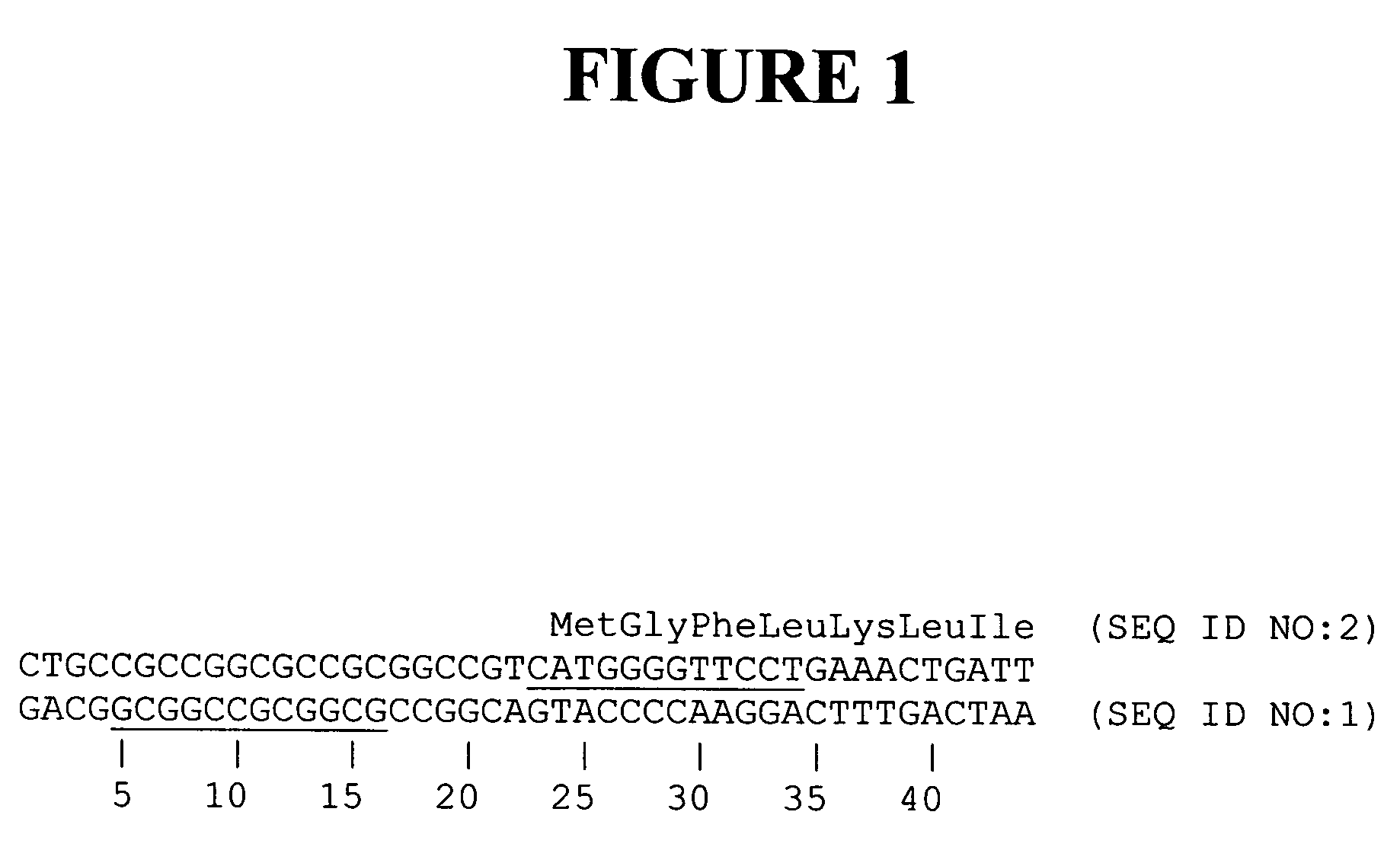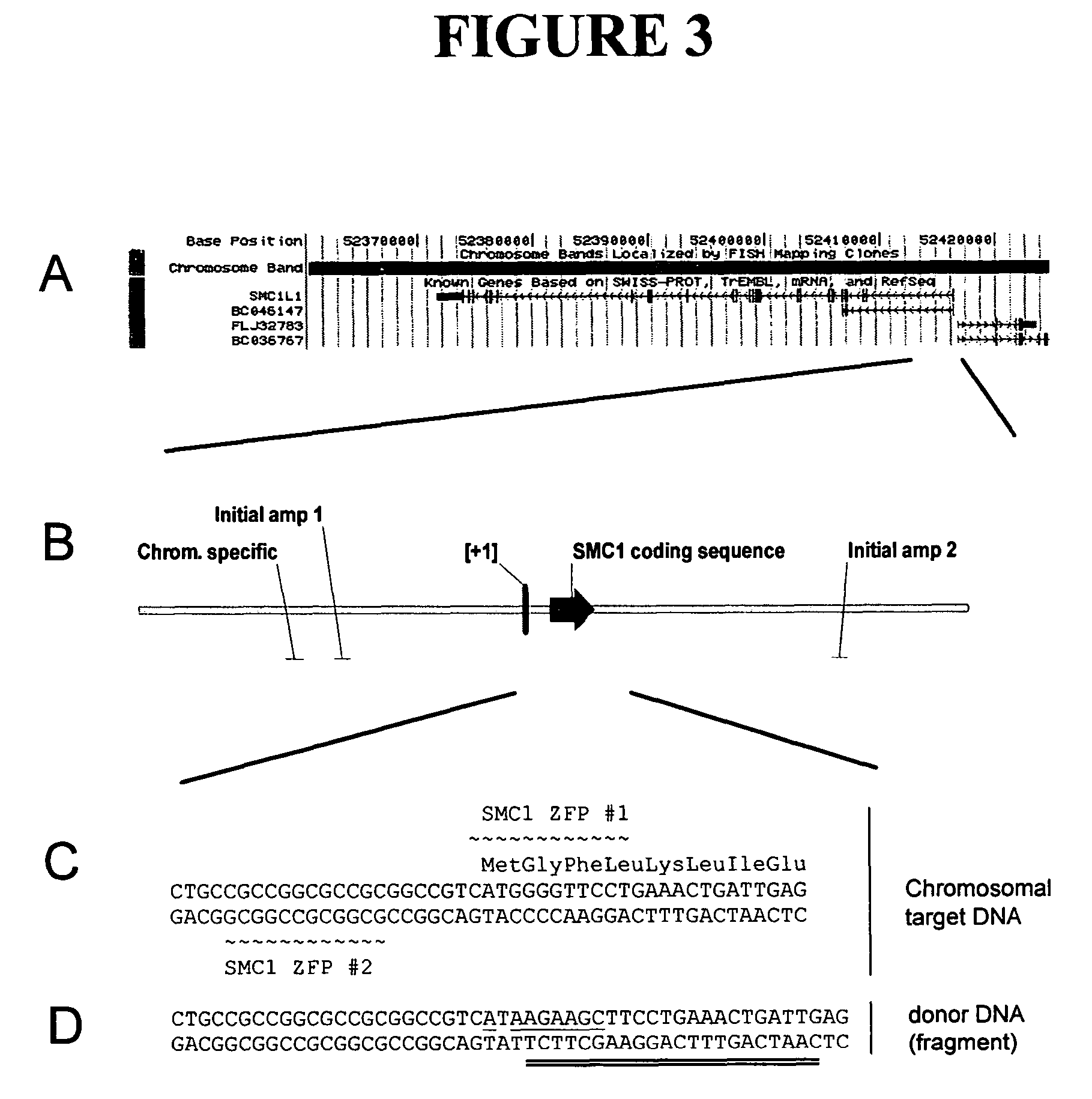Methods and compositions for targeted cleavage and recombination
a technology of cleavage and recombination, applied in the field of gene engineering and homologous recombination, can solve the problems of inapplicability and extremely low homologous recombination frequency, and achieve the effect of inhibiting the expression or activity of proteins and enhancing the frequency of homologous recombination
- Summary
- Abstract
- Description
- Claims
- Application Information
AI Technical Summary
Benefits of technology
Problems solved by technology
Method used
Image
Examples
example 1
Editing of a Chromosomal hSMC1L1 Gene by Targeted Recombination
The hSMC 1L1 gene is the human orthologue of the budding yeast gene structural maintenance of chromosomes 1. A region of this gene encoding an amino-terminal portion of the protein which includes the Walker ATPase domain was mutagenized by targeted cleavage and recombination. Cleavage was targeted to the region of the methionine initiation codon (nucleotides 24-26, FIG. 1), by designing chimeric nucleases, comprising a zinc finger DNA-binding domain and a FokI cleavage half-domain, which bind in the vicinity of the codon. Thus, two zinc finger binding domains were designed, one of which recognizes nucleotides 23-34 (primary contacts along the top strand as shown in FIG. 1), and the other of which recognizes nucleotides 5-16 (primary contacts along the bottom strand). Zinc finger proteins were designed as described in co-owned U.S. Pat. Nos. 6,453,242 and 6,534,261. See Table 2 for the amino acid sequences of the recognit...
example 2
Editing of a Chromosomal IL2Rγ Gene by Targeted Recombination
The IL-2Rγ gene encodes a protein, known as the “common cytokine receptor gamma chain,” that functions as a subunit of several interleukin receptors (including IL-2R, IL-4R, IL-7R, IL-9R, IL-15R and IL-21R). Mutations in this gene, including those surrounding the 5′ end of the third exon (e.g. the tyrosine 91 codon), can cause X-linked severe combined immunodeficiency (SCID). See, for example, Puck et al. (1997) Blood 89:1968-1977. A mutation in the tyrosine 91 codon (nucleotides 23-25 of SEQ ID NO: 7; FIG. 7), was introduced into the IL2Rγ gene by targeted cleavage and recombination. Cleavage was targeted to this region by designing two pairs of zinc finger proteins. The first pair (first two rows of Table 4) comprises a zinc finger protein designed to bind to nucleotides 29-40 (primary contacts along the top strand as shown in FIG. 7) and a zinc finger protein designed to bind to nucleotides 8-20 (primary contacts along ...
example 3
Editing of a Chromosomal β-Globin Gene by Targeted Recombination
The human beta globin gene is one of two gene products responsible for the structure and function of hemoglobin in adult human erythrocytes. Mutations in the beta-globin gene can result in sickle cell anemia. Two zinc finger proteins were designed to bind within this sequence, near the location of a nucleotide which, when mutated, causes sickle cell anemia. FIG. 13 shows the nucleotide sequence of a portion of the human beta-globin gene, and the target sites for the two zinc finger proteins are underlined in the sequence presented in FIG. 13. Amino acid sequences of the recognition regions of the two zinc finger proteins are shown in Table 6. Sequences encoding each of these two ZFP binding domains were fused to sequences encoding a FokI cleavage half-domain, as described above, to create engineered ZFP-nucleases that targeted the endogenous beta globin gene. Each of these fusion sequences was then cloned in the mammali...
PUM
 Login to View More
Login to View More Abstract
Description
Claims
Application Information
 Login to View More
Login to View More - R&D
- Intellectual Property
- Life Sciences
- Materials
- Tech Scout
- Unparalleled Data Quality
- Higher Quality Content
- 60% Fewer Hallucinations
Browse by: Latest US Patents, China's latest patents, Technical Efficacy Thesaurus, Application Domain, Technology Topic, Popular Technical Reports.
© 2025 PatSnap. All rights reserved.Legal|Privacy policy|Modern Slavery Act Transparency Statement|Sitemap|About US| Contact US: help@patsnap.com



